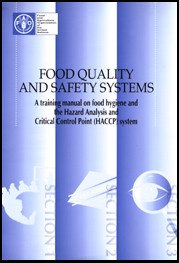
Food Quality and Standards Service Food and Nutrition Division
FOOD AND AGRICULTURE ORGANIZATION OF THE UNITED NATIONS
Rome, 1998
Editing, design, graphics and desktop publishing:
Publishing Management Group, FAO Information Division
Reprinted with corrections 1998
|
The designations employed and the presentation of material in this publication do not imply the expression of any opinion whatsoever on the part of the Food and Agriculture Organization of the United Nations concerning the legal status of any country, territory, city or area or of its authorities, or concerning the delimitation of its frontiers or boundaries. |
M-83
ISBN 92-5-104115-6
All rights reserved. No part of this publication may be reproduced, stored in a retrieval system, or transmitted in any form or by any means, electronic, mechanical, photocopying or otherwise, without the prior permission of the copyright owner. Applications for such permission, with a statement of the purpose and extent of the reproduction, should be addressed to the Director, Information Division, Food and Agriculture Organization of the United Nations, Viale delle Terme di Caracalla, 00100 Rome, Italy.
© FAO 1998
This electronic document has been scanned using optical character recognition (OCR) software and careful manual recorrection. Even if the quality of digitalisation is high, the FAO declines all responsibility for any discrepancies that may exist between the present document and its original printed version.
Section 1 - PRINCIPLES AND METHODS OF TRAINING
Introduction
Module 1 - Principles of effective communication - "Getting the message across"
Module 2 - Effective oral communication
Module 3 - Why train? The trainer's role and responsibility
Module 4 - Methods of training - The right method
Module 5 - The art of questioning
Module 6 - Types of training aids - How to make and use them
Module 7 - Planning and delivering a presentation
Module 8 - Evaluating training
Module 9 - Testing trainee trainers - Individual presentations
Module 10 - Organizing and managing a training course
Section 2 - RECOMMENDED INTERNATIONAL CODE OF PRACTICE - GENERAL PRINCIPLES OF FOOD HYGIENE
Introduction
Module 1 - The Codex Alimentarius Commission
Module 2 - The Codex General Principles of Food Hygiene
Module 3 - Primary production
Module 4 - Establishment: design and facilities
Module 5 - Control of operation
Module 6 - Establishment: maintenance and sanitation
Module 7 - Establishment: personal hygiene
Module 8 - Transportation
Module 9 - Product information and consumer awareness
Module 10 - Training
Section 3 - THE HAZARD ANALYSIS AND CRITICAL CONTROL POINT (HACCP) SYSTEM
Introduction
Module 1 - History and background of the HACCP system
Module 2 - The Codex guidelines for the application of the HACCP system
Module 3 - Assemble the HACCP team - Task 1
Module 4 - Describe product and identify intended use - Tasks 2 and 3
Module 5 - Construct flow diagram and on-site confirmation of flow diagram - Tasks 4 and 5
Module 6 - List all potential hazards associated with each step, conduct a hazard analysis and consider any measures to control identified hazards - Task 6/Principle 1
Module 7 - Determine critical control points - Task 7/Principle 2
Module 8 - Establish critical limits for each critical control point - Task 8/Principle 3
Module 9 - Establish a monitoring system for each critical control point - Task 9/Principle 4
Module 10 - Establish corrective actions - Task 10/Principle 5
Module 11 - Establish verification procedures - Task 11/Principle 6
Module 12 - Establish documentation and record keeping - Task 12/Principle 7
Annex 2 - The application of risk analysis to food safety control programmes